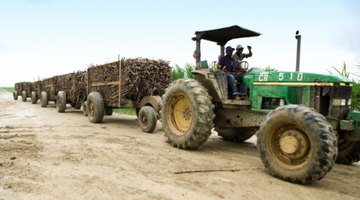The Life Cycle of a Sugarcane Plant
Sugarcane, or Saccharum officinarum, is a tropical grass that is the source of about 75 percent of the world’s sugar supply. It has a long life cycle, requiring warm weather and heavy rainfall or irrigation throughout its growing season.

Planting
Sugarcane is usually planted from 12-inch pieces of stems of existing plants, although some growers begin with seeds. The grower digs furrows, inserts the cut stems and then covers them with a small amount of soil. For large-scale growing situations, machinery is available that cuts and plants the stems or canes.
Growth Period
During the nine to 24 months sugarcane takes to grow to maturity, it needs a large quantity of water. Sugarcane needs up to 60 inches of rain or irrigation while it is actively growing, but it later needs no rain or irrigation during its ripening phase. It also needs full sun.
Seed Formation
Eight to 12 months after planting the sugarcane, the plant reaches about 15 feet in height. It then sends up tall flower stalks, which contain many seeds. At this time in its life cycle, the sugarcane plant has a high content of sucrose.
Harvest
Sugarcane fields used to be burned to eliminate leaves and weeds. Now, harvesting machinery travels through the rows, removing unwanted weeds and leaves. Harvest typically occurs between June and December, which is a dry period for many tropical locales.
References
Writer Bio
Barbara Fahs lives on Hawaii island, where she has created Hi'iaka's Healing Herb Garden. Fahs wrote "Super Simple Guide to Creating Hawaiian Gardens" and has been a professional writer since 1984. She contributes to "Big Island Weekly," "Ke Ola" magazine and various websites. She earned her Bachelor of Arts at University of California, Santa Barbara and her Master of Arts from San Jose State University.
Photo Credits
- Jupiterimages/Photos.com/Getty Images
- Jupiterimages/Photos.com/Getty Images
More Articles



